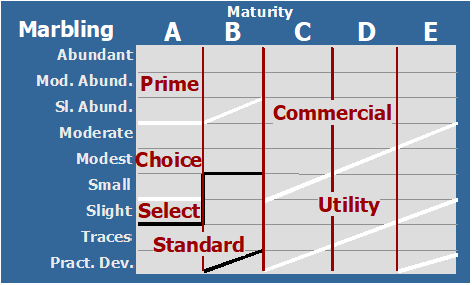Beef Quality Grades
Mark Z. Johnson, Oklahoma State University Extension Beef Cattle Breeding Specialist
United States Department of Agriculture (USDA) Beef Quality Grades assigned to beef carcasses indicate the tenderness, juiciness and flavor of cooked beef. Beef Quality Grades are based on: 1) the degree of marbling a USDA grader finds in the ribeye muscle of a ribbed carcass between the 12th and 13th ribs, and 2) the maturity of the carcass. The “A” Maturity designation means that a hanging beef carcass shows a degree of maturity between 9 – 30 months of age. Accordingly, if you send lighter calves or long yearlings to the feed yard, after the typical finishing phase of at least 150 days of a high energy, corn-based ration fed ad lib, they should yield an A maturity carcass. Because of this, marbling score is the primary factor determining Quality Grades in A maturity beef carcasses. In conventional beef production, cattle are fed for an amount of time to reach a compositional endpoint with the objective of tapping their full genetic potential to grow and develop marbling. Marbling is one type of fat we find in the carcass (external fat, seam fat and kidney heart and pelvic fat.
(KPH) will be discussed next week when we cover Beef Yield Grades). Marbling is commonly referred to as intramuscular fat because of where it is found within the ribeye muscle. As such, marbling can’t be seen in live animals. Therefore, the compositional endpoint to which cattle are fed is based on external finish. Because of its location in the beef carcass, marbling has more influence on tenderness, juiciness and flavor of cooked beef than the other types of fat. As a result, marbling and Beef Quality Grades are typically the biggest driver of beef carcass value. From highest to lowest, the four Quality grades that exist for A maturity beef carcasses are: Prime, Choice, Select and Standard.

The chart shows how marbling scores down the left hand column relate to Beef Quality Grades. Three marbling scores are shown beside the Prime and Choice Quality Grades permitting the Grades to be split into thirds. For example, Moderate and Modest Marbling scores are connected to the upper 2/3rds of the Choice Grade which is a specification threshold for carcasses to be certified for quality based premium branded programs like Certified Angus Beef (CAB). As well, when beef carcasses fall into the B, C, D, and E maturity groups, lower Quality Grades are assigned and there is no longer potential for the best Quality Grades.
Beyond marbling and maturity looked at in the carcass, the amount of time on feed and the genetic potential and breed type of beef cattle plays a big role in Quality Grades achieved. Marbling is one of the later maturing fat types to develop. A wide range of genetic propensity to grow and develop marbling relative to other types of fat exists within and between different beef breeds.
